How to Enable or Disable Smart App Control in Windows 11
Have you ever downloaded an app that was more trouble than it’s worth? We’ve all been there. Fortunately, Windows 11 has a built-in security feature called Smart App Control to help you steer clear of shady software. This article will guide you to enable or disable Smart App Control on Windows 11 PC.

But first things first, what exactly is Smart App Control, and how does it work? Smart App Control is a security feature that offers extra protection and complements existing security features like Windows Defender. It uses Microsoft’s app intelligence services and code integrity checks to block untrusted, malicious, and potentially unwanted apps (PUAs) that slow down your PC, display unexpected ads, install unwanted software, or engage in other undesirable activities.
With this understanding, let’s enable the Smart App Control feature on your Windows 11 machine.
How to Turn on Smart App Control in Windows 11
There are multiple ways to enable Smart App Control in Windows 11. We will explain each method step-by-step. Let’s begin with one of the most common and easiest ways.
1. Using Settings
Step 1: Press the Windows key on your keyboard, type Settings, and click Open.
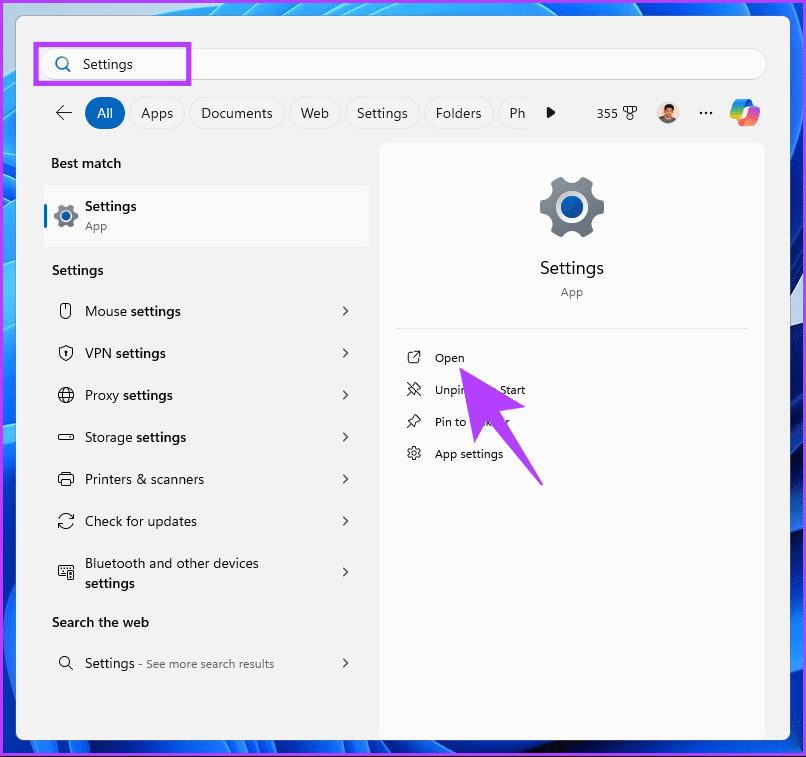
Step 2: Navigate to ‘Privacy & security’ from the side pane. On the right pane, under Security, click on Windows Security.
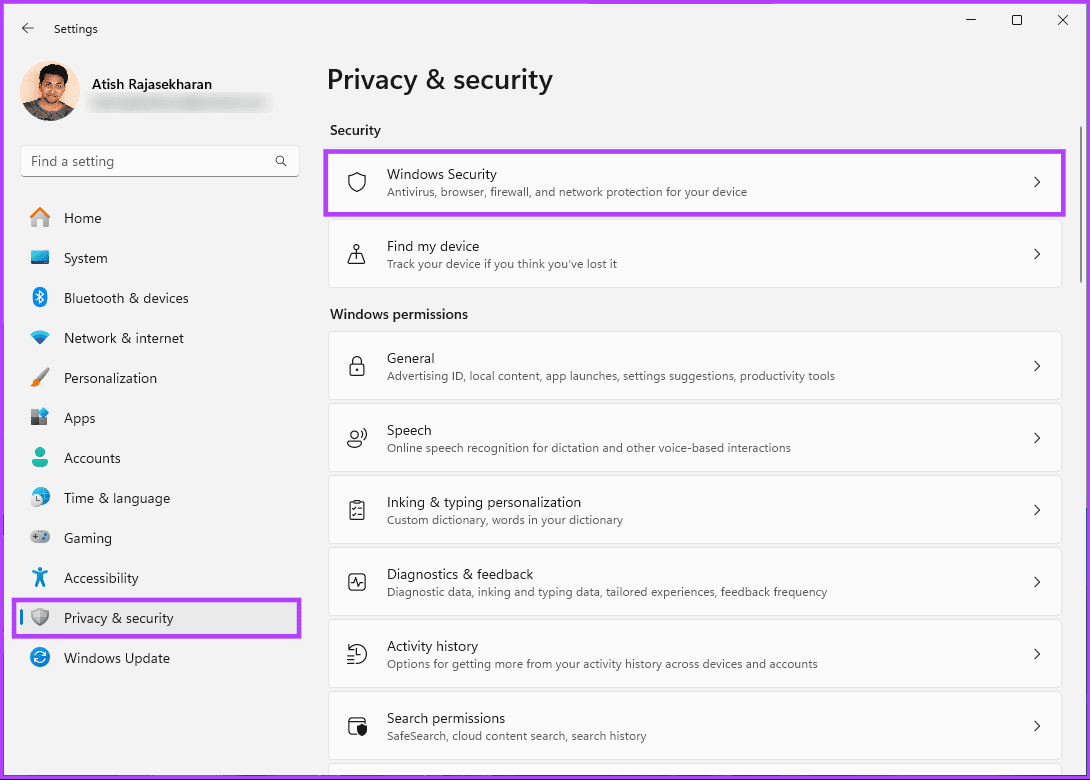
Step 3: Click on ‘Open Windows Security.’ This will launch the Windows Security window.
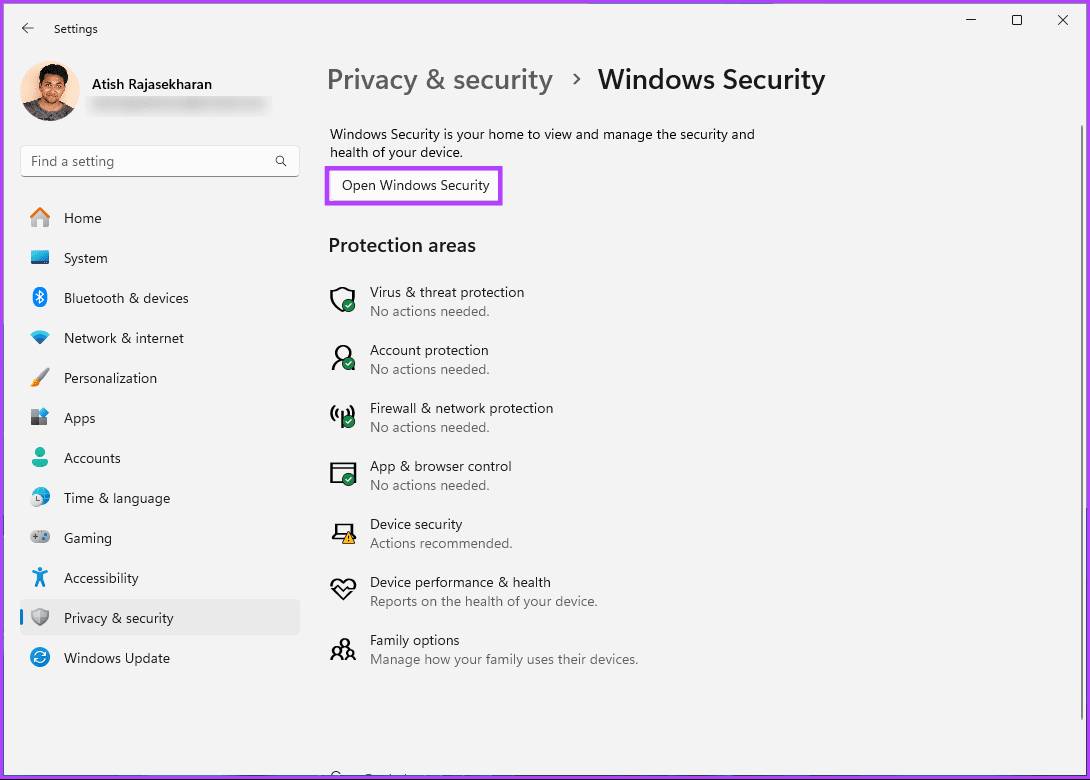
Step 4: Go to ‘App & browser control’ on the left pane and choose ‘Smart App Control settings’ under Smart App Control on the right.
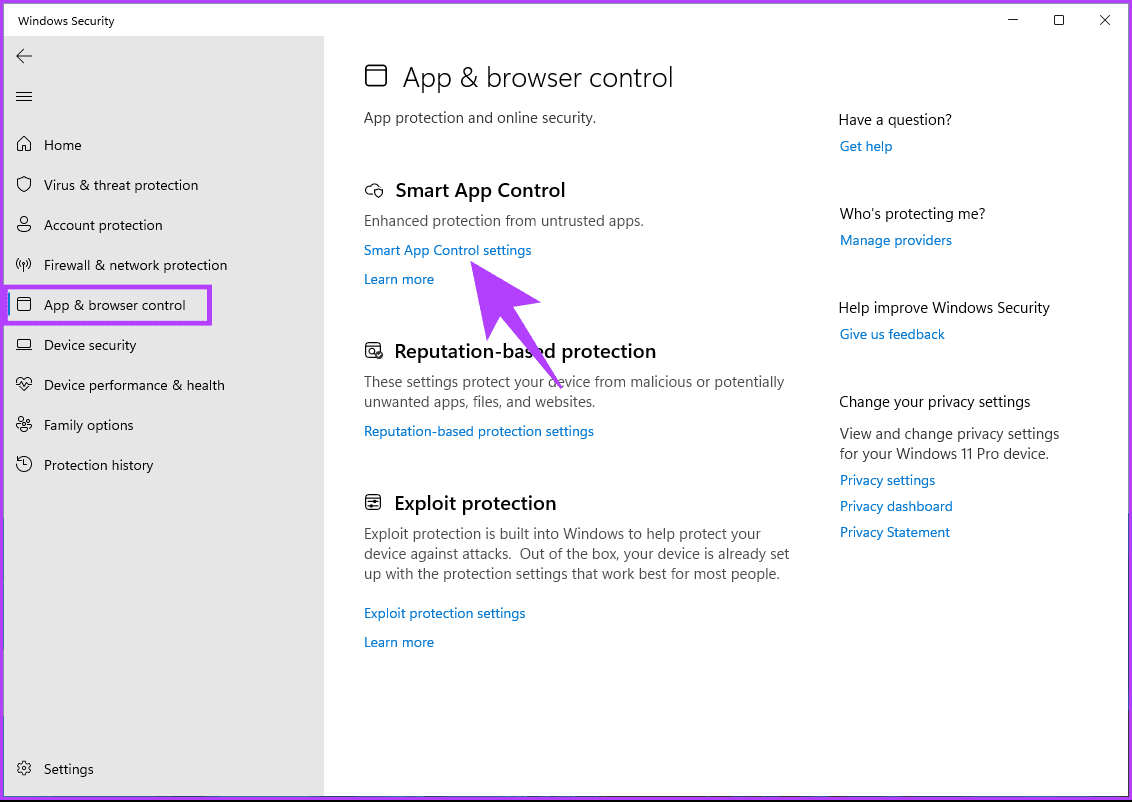
Step 5: Finally, select On to enable Smart App Control on your Windows.
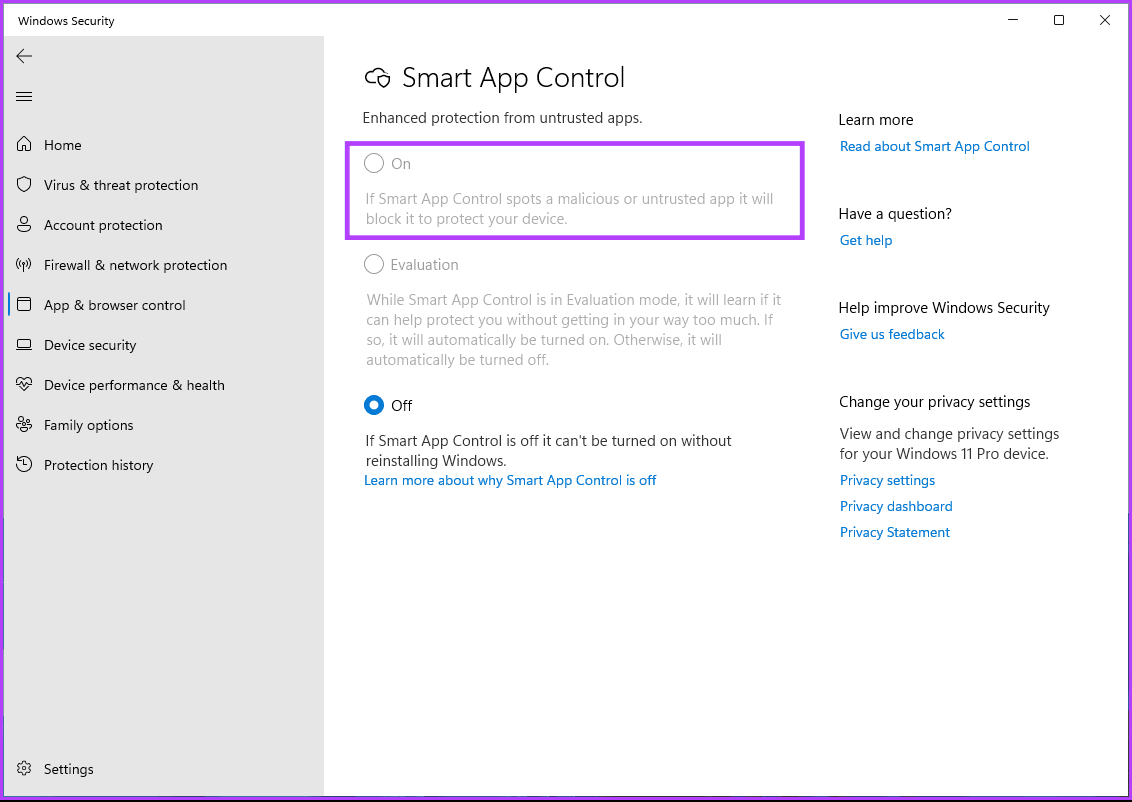
That’s it. You have successfully enabled Smart App Control on your Windows 11 PC.
2. Using the Registry Editor
This method is more complex than the above one, but the steps are simple to follow. However, because we will use the Registry Editor, we recommend backing up the Windows Registry before proceeding with the steps below.
Step 1: Press the Windows key on your keyboard, type Registry Editor, and click ‘Run as administrator.’
Note: Alternatively, press the Windows R key to open the Run dialog box, type regedit.exe, and click OK to open Registry Editor.
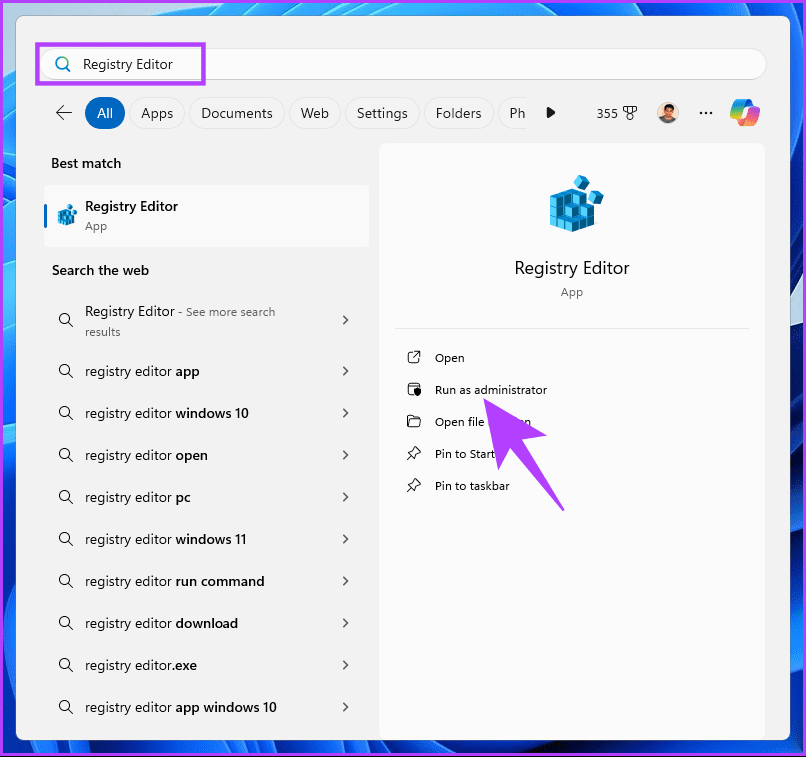
In the prompt, select Yes.
Step 2: In the top address bar, enter the following path:
HKEY_LOCAL_MACHINE\SYSTEM\CurrentControlSet\Control\CI\Policy
Note: You can manually navigate to the section too.
Step 3: Find and double-click on the VerifiedAndReputablePolicyState key.
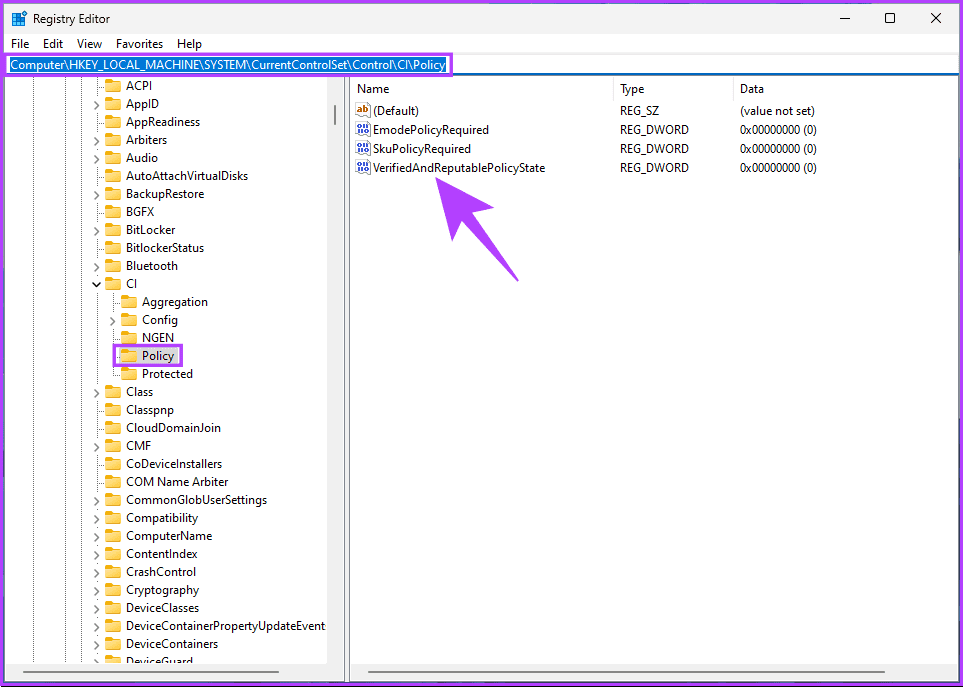
Step 4: Now, type 1 in the Value Data field to enable Smart App Control, or type 2 to put Smart App Control in Evaluation mode and press OK.
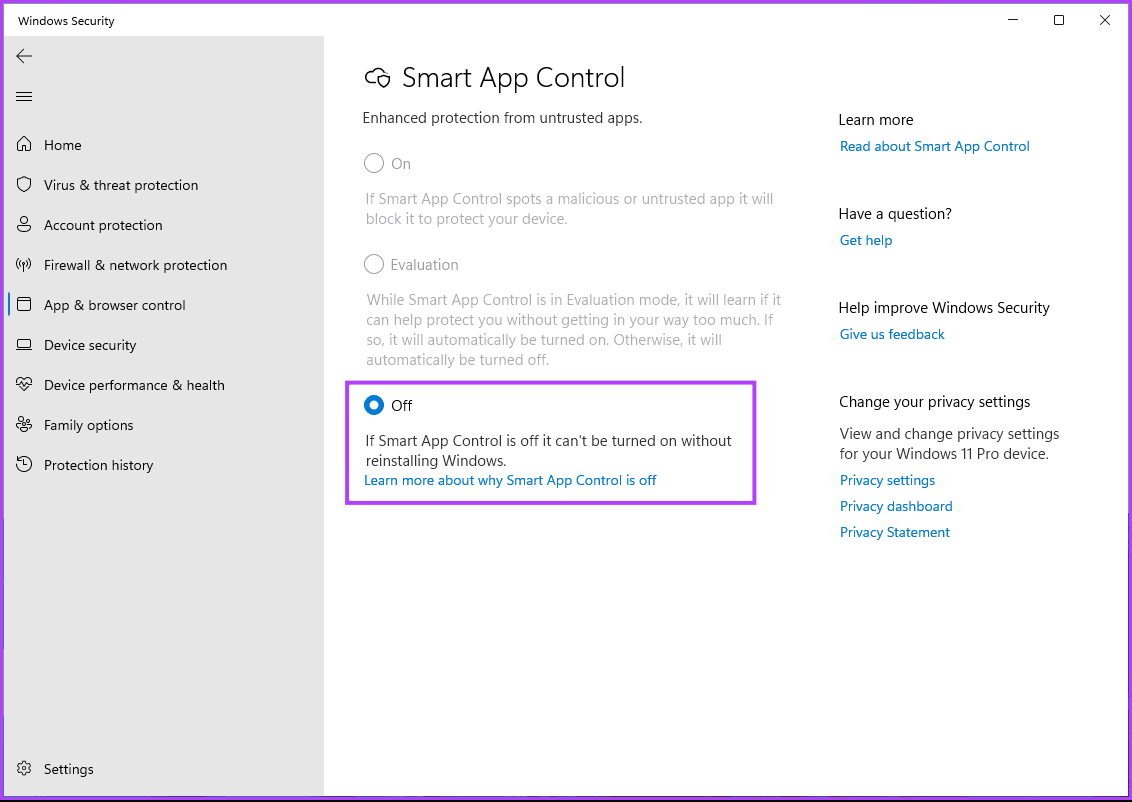
Finally, reboot the system to implement the changes. And that’s it! After booting up your PC again, Smart App Control will be enabled or in evaluation mode, depending on the value you inputted.
How to Turn Off Smart App Control on Windows 11
It is essential to note that if you disable Smart App Control, you will no longer receive warnings about potentially harmful apps. This means you can install any app you want, regardless of its origin. However, it is essential to be careful about the apps that you install, as disabling Smart App Control will leave you more vulnerable to malware and other threats.
That said, you might want to disable Smart App Control for a few reasons. For example, if you frequently download and install apps from outside the Microsoft Store, Smart App Control might occasionally block legitimate apps. Additionally, Smart App Control can sometimes cause false positives, mistakenly identifying a safe app as harmful. Follow the below-mentioned steps.
Step 1: Press the Windows key on your keyboard, type Settings, and click Open.

Step 2: Navigate to ‘Privacy & security’ from the side pane. On the right pane, click on Windows Security under Security.

Step 3: Click on ‘Open Windows Security.’

This will launch the Windows Security window.
Step 4: Go to ‘App & browser control’ on the left pane and choose ‘Smart App Control settings’ under Smart App Control on the right.

Step 5: Finally, select Off to disable Smart App Control on your Windows.

Step 6: In the pop-up menu, click on ‘Yes, I’m sure.’ to disable Smart App Control.
There you have it. You have successfully turned off Smart App Control on your Windows 11 PC.
FAQs About Smart App Control in Windows 11
Smart App Control is a security feature that compliments the existing security feature on Windows. If you mainly use trusted apps, practice safe online habits, and already have antivirus software, you might be okay without enabling Smart App Control on your Windows PC.
Yes, disabling Smart App Control increases the risk of malware and unwanted software infecting your PC. It acts as a safety net, blocking untrusted and potentially harmful applications.
Currently, there is no way to bypass Smart App Control protection for individual apps. If Smart App Control is blocking an app you trust, you can add it to the exclusion list or disable Smart App Control completely.
Keep Your Windows Secure
Now that you know how to enable or disable Smart App Control in Windows 11, you can proactively protect your PC from harmful applications. However, Smart App Control is still evolving and cannot eliminate malware apps. So, practice safe browsing habits and download apps from trusted sources. You can also learn how to enable the Local Security Authority process in Windows 11.
-
 How to delete your data from a person search siteThis article was last updated on February 24, 2025. Many people are unaware that a significant amount of their personal data is readily accessible on...Software tutorial Posted on 2025-04-21
How to delete your data from a person search siteThis article was last updated on February 24, 2025. Many people are unaware that a significant amount of their personal data is readily accessible on...Software tutorial Posted on 2025-04-21 -
 How to disguise an iPad as a laptopThis updated article (originally published October 31, 2019) explores how to transform your iPad into a laptop alternative using iPadOS 16 beta featur...Software tutorial Posted on 2025-04-21
How to disguise an iPad as a laptopThis updated article (originally published October 31, 2019) explores how to transform your iPad into a laptop alternative using iPadOS 16 beta featur...Software tutorial Posted on 2025-04-21 -
 How to clean Mac mailbox cache? How to delete it on Mac?This guide explains how to clear the Mail cache on your Mac, addressing common issues like slow performance and email loading problems. The macOS Mai...Software tutorial Posted on 2025-04-21
How to clean Mac mailbox cache? How to delete it on Mac?This guide explains how to clear the Mail cache on your Mac, addressing common issues like slow performance and email loading problems. The macOS Mai...Software tutorial Posted on 2025-04-21 -
 How to prioritize the allocation of WiFi to the most needed devicesModern homes usually have multiple devices connected to Wi-Fi access networks simultaneously, which often leads to bandwidth tightness, especially w...Software tutorial Posted on 2025-04-19
How to prioritize the allocation of WiFi to the most needed devicesModern homes usually have multiple devices connected to Wi-Fi access networks simultaneously, which often leads to bandwidth tightness, especially w...Software tutorial Posted on 2025-04-19 -
 McAfee antivirus software review: Is it enough? 【Function, Price】McAfee: A Veteran Antivirus, But Is It the Best for Macs? McAfee, a long-standing and reputable name in cybersecurity, offers a robust antivirus suite...Software tutorial Posted on 2025-04-19
McAfee antivirus software review: Is it enough? 【Function, Price】McAfee: A Veteran Antivirus, But Is It the Best for Macs? McAfee, a long-standing and reputable name in cybersecurity, offers a robust antivirus suite...Software tutorial Posted on 2025-04-19 -
 OnePlus Watch 3 is postponed to April due to funny issuesAfter the long-awaited OnePlus Watch 3 smartwatch is released, the purchase plan may require a slight adjustment. A ridiculous production problem has...Software tutorial Posted on 2025-04-19
OnePlus Watch 3 is postponed to April due to funny issuesAfter the long-awaited OnePlus Watch 3 smartwatch is released, the purchase plan may require a slight adjustment. A ridiculous production problem has...Software tutorial Posted on 2025-04-19 -
 Tips to make the most of the tap function on the back of your iPhoneOver the years, Apple has developed a large number of tools to make using iPhones more convenient. Although the "Tap Back" feature is dull,...Software tutorial Posted on 2025-04-18
Tips to make the most of the tap function on the back of your iPhoneOver the years, Apple has developed a large number of tools to make using iPhones more convenient. Although the "Tap Back" feature is dull,...Software tutorial Posted on 2025-04-18 -
 Quickly get Windows 11 24H2 updates, skip the waiting queueIn the comprehensive guide, MiniTool will walk you through how to bypass Windows 11 24H2 waiting line using Group Policy and Registry. Take action if ...Software tutorial Posted on 2025-04-18
Quickly get Windows 11 24H2 updates, skip the waiting queueIn the comprehensive guide, MiniTool will walk you through how to bypass Windows 11 24H2 waiting line using Group Policy and Registry. Take action if ...Software tutorial Posted on 2025-04-18 -
 Tips for using mobile phone hotspots: How to avoid the surge in data trafficUsing your phone as a hotspot for your laptop on the go is convenient, but laptops are data hogs. Unlike phones, which prioritize Wi-Fi for tasks like...Software tutorial Posted on 2025-04-18
Tips for using mobile phone hotspots: How to avoid the surge in data trafficUsing your phone as a hotspot for your laptop on the go is convenient, but laptops are data hogs. Unlike phones, which prioritize Wi-Fi for tasks like...Software tutorial Posted on 2025-04-18 -
 Which one is better compared to iPhone and Android?Choosing between iOS and Android: A Detailed Comparison The mobile phone market is dominated by two major players: iOS and Android. Both boast millio...Software tutorial Posted on 2025-04-17
Which one is better compared to iPhone and Android?Choosing between iOS and Android: A Detailed Comparison The mobile phone market is dominated by two major players: iOS and Android. Both boast millio...Software tutorial Posted on 2025-04-17 -
 Safari slows down on Mac? The secret to speeding up safari!Safari browser runs slowly? A must-see guide to acceleration for Mac users! Safari is one of the fastest browsers on Mac, but it is also not complete...Software tutorial Posted on 2025-04-17
Safari slows down on Mac? The secret to speeding up safari!Safari browser runs slowly? A must-see guide to acceleration for Mac users! Safari is one of the fastest browsers on Mac, but it is also not complete...Software tutorial Posted on 2025-04-17 -
 I thought I would never need a wallet until this happenedYou’re in a nice restaurant with your beloved; perhaps both of you are enjoying a lovely steak. After a while, you raise your hand and ask the waiter ...Software tutorial Posted on 2025-04-17
I thought I would never need a wallet until this happenedYou’re in a nice restaurant with your beloved; perhaps both of you are enjoying a lovely steak. After a while, you raise your hand and ask the waiter ...Software tutorial Posted on 2025-04-17 -
 Comparison between McAfee and MacKeeper: Which one is better? How to choose antivirus software?Choosing the right cybersecurity solution for your Mac can be tricky. This comparison of McAfee and MacKeeper helps you decide between a well-establi...Software tutorial Posted on 2025-04-17
Comparison between McAfee and MacKeeper: Which one is better? How to choose antivirus software?Choosing the right cybersecurity solution for your Mac can be tricky. This comparison of McAfee and MacKeeper helps you decide between a well-establi...Software tutorial Posted on 2025-04-17 -
 7 security communication apps you should useChoosing a messaging app often boils down to what your contacts use, overlooking a crucial factor: security. We share incredibly sensitive informatio...Software tutorial Posted on 2025-04-17
7 security communication apps you should useChoosing a messaging app often boils down to what your contacts use, overlooking a crucial factor: security. We share incredibly sensitive informatio...Software tutorial Posted on 2025-04-17 -
 The ultimate guide to how to label any websiteBeyond Static: Annotating Web Pages with Ease The web shouldn't be a static experience. With the right tools, you can actively engage with websit...Software tutorial Posted on 2025-04-17
The ultimate guide to how to label any websiteBeyond Static: Annotating Web Pages with Ease The web shouldn't be a static experience. With the right tools, you can actively engage with websit...Software tutorial Posted on 2025-04-17
Study Chinese
- 1 How do you say "walk" in Chinese? 走路 Chinese pronunciation, 走路 Chinese learning
- 2 How do you say "take a plane" in Chinese? 坐飞机 Chinese pronunciation, 坐飞机 Chinese learning
- 3 How do you say "take a train" in Chinese? 坐火车 Chinese pronunciation, 坐火车 Chinese learning
- 4 How do you say "take a bus" in Chinese? 坐车 Chinese pronunciation, 坐车 Chinese learning
- 5 How to say drive in Chinese? 开车 Chinese pronunciation, 开车 Chinese learning
- 6 How do you say swimming in Chinese? 游泳 Chinese pronunciation, 游泳 Chinese learning
- 7 How do you say ride a bicycle in Chinese? 骑自行车 Chinese pronunciation, 骑自行车 Chinese learning
- 8 How do you say hello in Chinese? 你好Chinese pronunciation, 你好Chinese learning
- 9 How do you say thank you in Chinese? 谢谢Chinese pronunciation, 谢谢Chinese learning
- 10 How to say goodbye in Chinese? 再见Chinese pronunciation, 再见Chinese learning

























